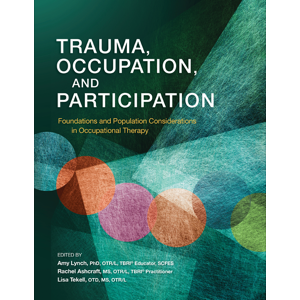
Amy Lynch, associate professor of instruction in the occupational therapy program, has edited a new textbook that represents a first in occupational therapy: a comprehensive guide to help practitioners and students better understand and respond to trauma experienced by the clients they serve.
“It’s what we do every day as OTs, but there hasn’t been a master textbook. It was a book that needed to be written and I was honored to be called upon to serve our profession in this manner,” says Lynch, who is the lead editor and co-authored several chapters of Trauma, Occupation, and Participation: Foundations and Population Considerations in Occupational Therapy.
Occupational therapists help people who may have physical, mental, emotional, sensory or cognitive problems participate in daily activities and regain independence. The work may involve helping a child participate more fully in school and social situations, helping an injured worker regain skills, or supporting older adults who are experiencing cognitive or physical issues. Experiences of trauma at any age, whether acute or chronic, can affect all of these OT clients and influence their outcomes in different ways.
Lynch believes it’s essential for OTs to understand how trauma affects people and to make that awareness a vital component of interventions with patients. Even before the pandemic, she says, 60 percent of adults reported having had at least one adverse childhood experience prior to age 16.
“When we think about the relationship between adverse childhood experiences and health and wellness outcomes such as obesity, stroke, cancer, anxiety and depression, occupational therapy is working with all of those clients,” Lynch says. “We need to understand how trauma affects the way people think and respond.”
With co-editors Rachel Ashcraft, president of the Alabama Occupational Therapy Association, and Lisa Tekell, an occupational therapist from Iowa, Lynch assembled experts from around the world to contribute chapters. The book begins with foundational information for all practitioners on topics such as becoming a trauma-informed practitioner and the neurobiology of trauma, then includes a dozen chapters specific to particular environments and populations.
“We really wanted to get contributors who are out in the field in different contexts,” Lynch explains. “What is it like to be an OT in the criminal justice system? Are you working with people who are homeless? Are you working with children in the foster care system? In a traditional medical rehab unit? For each of these clients, experiences of trauma disrupt participation in activities, satisfaction with participation, and self-worth every day. Each chapter has the same format, but different content.”
The book, published by the American Occupational Therapy Association’s AOTA Press, is aimed at OT students as well as practicing clinicians.
“I would really like to see universities adopt it,” she says. “With the different content and context areas covered, there is a chapter in this book that would be a wonderful asset for every class and every occupational therapy curriculum.”
